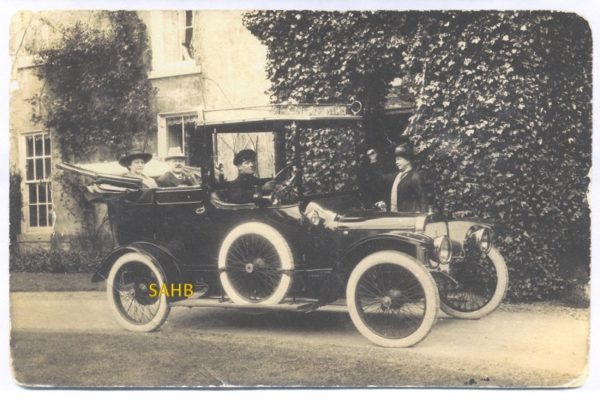
Here’s a posed photograph that illustrates to perfection a common aspect of motoring in the immediate Pre-Great War era. The car looks just about new, although here we may be doing a disservice to the diligence of the proud chauffeur, seen at the wheel. In the open rear compartment of this single landaulette body sit a couple who clearly are the owners of the car; worthy middle-aged citizens fully in keeping with the overall setting. Another respectable lady poses, waving as if to acknowledge their imminent departure. It is a summer’s day and the calm confidence of those years is fully apparent.
A first glance at the car suggests Argyll as a make, based upon the shape of bonnet and radiator design. But not so: by 1912-14, Argylls had front wheel brakes, obviously missing here. The radiator of the BSA of these same period was quite closely similar to that better known on Argyll cars, but the latter carried circular badges, whereas that of the BSA was more of a strip, as here. Other clues to the BSA make are the spidery wheels, large diameter, thin section tyres and a multiplicity of fine wire spokes radiating from a smallish hub. Contemporary Daimlers shared this feature, and it had been BSA that had taken over the Daimler concern in 1910. One result of the takeover was the adoption by BSA of the Knight double sleeve-valve engine for a new model, the 13·9hp which remained current and indeed the sole BSA model from 1911 to 1915. And this is what we see here, the electric lighting suggesting a date of manufacture towards the latter part of those years.
Prior to becoming prominent in cycle manufacture from 1880, BSA (Birmingham Small Arms Ltd) were major makers of guns, hence their badge, three stacked rifles. Both their firearms and cycles were to continue for many decades to come, whilst car production tended to come and go. Up to 1911, there had been three different and larger models of BSA car. There followed another burst of activity in the mid-1920s and then again in the 1930s with the front wheel drive three-wheeler.
Back to our featured BSA: the bore and stroke of the four cylinder engine were 75 x 114mm, giving a capacity of 2015cc; a smallish power unit that would have had its work cut out to propel this chassis with its heavy coachwork at anything beyond the most gentle of paces. In addition to the ‘Silent Knight’ engine, there were one or two further unexpected features of the design – the rear suspension was by a single transverse leaf spring, and the 3-speed gearbox was incorporated in the rear axle assembly, the final drive being by worm and wheel. Those tiny rear brake drums were not assisted by the transmission brake that was common at that period, and two sets of shoes lived inside each drum, one operated by the hand lever, the other by pedal.
The chauffeur received his instructions through a small trumpet from a mouthpiece in the rear and a push-down mechanical Klaxon by his right hand would be useful when those modest rear brakes reached the limit of their effectiveness. The mesh-sided rack on the roof was for luggage. This same chassis, with a different radiator, was sold as the 12hp Stoneleigh car, a cut-price line from Siddeley-Deasy, another Coventry motor firm, but thought to be constructed by BSA.







My grandfather Ronald Edwin Green was appointed works body manager to BSA cars.
I have the Daimler embossed letter of appointment at £50pa more than previously paid.
He was a Great Horseless Carriage/Daimler apprentice from 1904. I think he remained with the company until about 1919/20.